The GodisaGeek Retro Corner: WWF Wrestlefest
Developer: Technos Japan
Publisher: Tecmo
Originally Released on: Arcade Machine
Currently Available on: Currently only playable via emulation
WWE All Stars, the upcoming over-the-top wrestling game from THQ, will feature superstars from both the past and present of the WWE with simplified, arcade-style controls. We recently previewed the game and you can now read the review of the title and the special controllers developed for use with the game. To celebrate that fact, the Retro Corner will be looking back into the past at a previous arcade wrestling title that featured slightly caricatured wrestlers and simplistic controls; WWF Wrestlefest.
 WWF WrestleFest is a professional wrestling video game that was developed by Technos and released in arcades in1991. A sequel to their earlier arcade game WWF Superstars which featured tag-team action, Technos didn’t stray from their winning formula but instead chose to expand the roster by doubling it to feature twelve wrestlers from the era. The title could support up to four players, depending on the cabinet setup, but it was the addition of the Royal Rumble mode that was the big hit with players.
WWF WrestleFest is a professional wrestling video game that was developed by Technos and released in arcades in1991. A sequel to their earlier arcade game WWF Superstars which featured tag-team action, Technos didn’t stray from their winning formula but instead chose to expand the roster by doubling it to feature twelve wrestlers from the era. The title could support up to four players, depending on the cabinet setup, but it was the addition of the Royal Rumble mode that was the big hit with players.
The core game mode was Saturday Night’s Main Event, a tag team tournament named after the wrestling television show of the same name. Players would pick a wrestler to control and a partner (or be joined by a second player) and compete over a series of matches in order to reach the final championship match-up against the Legion of Doom, who are not playable characters. To make this harder, Hawk and Animal (the two members of the Legion of Doom) both have health bars double the size of any other grappler in the game. Those who do win the belts will then have to go through the tournament again, successfully defending their championship, before they can say they have completed the game.
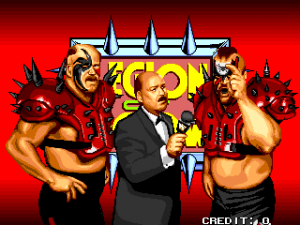 The other game mode is the Royal Rumble. For those of you who don’t know the rules, two grapplers enter the ring with a new opponent joining every sixty seconds, until thirty men have entered. The only way to win is to be the last man who hasn’t been eliminated by being thrown over the top rope. In Wrestlefest, the match was represented very accurately. Players could throw opponents out of the ring via grapples when positioned near the edge of the ring and when the other wrestlers’ energy was low enough. Breaking from the official Royal Rumble rules, a pinfall or submission would also eliminate a character. Up to six competitors could be in the ring at one time, and when a new wrestler was due to enter, a ten-second timer would appear on-screen. Before the next wrestler entered, they would appear in a pop-up insert in the corner of the screen and perform a taunt to the camera. All of these little extra details helped make the game feel more like a real WWF broadcast.
The other game mode is the Royal Rumble. For those of you who don’t know the rules, two grapplers enter the ring with a new opponent joining every sixty seconds, until thirty men have entered. The only way to win is to be the last man who hasn’t been eliminated by being thrown over the top rope. In Wrestlefest, the match was represented very accurately. Players could throw opponents out of the ring via grapples when positioned near the edge of the ring and when the other wrestlers’ energy was low enough. Breaking from the official Royal Rumble rules, a pinfall or submission would also eliminate a character. Up to six competitors could be in the ring at one time, and when a new wrestler was due to enter, a ten-second timer would appear on-screen. Before the next wrestler entered, they would appear in a pop-up insert in the corner of the screen and perform a taunt to the camera. All of these little extra details helped make the game feel more like a real WWF broadcast.
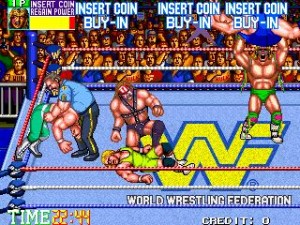 The madness of a Royal Rumble was made all the more palpable when playing with three friends. Four player wrestling gaming to date has never really been as good as it was here in WWF Wrestlefest. The simple style meant that it was easy to jump in and get straight into the action, for a multiplayer fix. Extra features in multiplayer mode added to the confusion of having six wrestlers on-screen at one time. Another player could kick you whilst you tried to pin a third, or break up a submission hold with a swift punch. Players would often knock each other over by mistake – especially when running between the ropes. That old-fashioned playground tradition, the “bundle”, was even present. Think you might not be able to hold down the mighty Ultimate Warrior for a three-count? Get two of your friends to jump on top as well, just to make sure. It is the little touches like this (which I have never seen in any other wrestling game since) that made the game so hilarious to play with friends, and let it accurately portray the “anything can happen” nature of pro wrestling.
The madness of a Royal Rumble was made all the more palpable when playing with three friends. Four player wrestling gaming to date has never really been as good as it was here in WWF Wrestlefest. The simple style meant that it was easy to jump in and get straight into the action, for a multiplayer fix. Extra features in multiplayer mode added to the confusion of having six wrestlers on-screen at one time. Another player could kick you whilst you tried to pin a third, or break up a submission hold with a swift punch. Players would often knock each other over by mistake – especially when running between the ropes. That old-fashioned playground tradition, the “bundle”, was even present. Think you might not be able to hold down the mighty Ultimate Warrior for a three-count? Get two of your friends to jump on top as well, just to make sure. It is the little touches like this (which I have never seen in any other wrestling game since) that made the game so hilarious to play with friends, and let it accurately portray the “anything can happen” nature of pro wrestling.
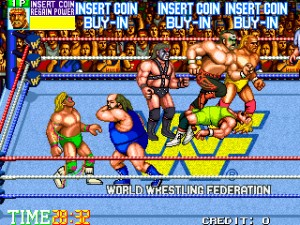 Gameplay is very simplistic with arcade machines only providing two action buttons for use in the game. One would control grapple, the other striking. The simple controls were easy enough for most gamers to pick up and play straight away, but were also context-sensitive, which allowed for quite some variety in moves that could be performed. Punches and kicks would be performed with the strike button depending on the situation, whether that be with both fighters standing, with one on the ground or when performing an aerial move from the top turnbuckle.
Gameplay is very simplistic with arcade machines only providing two action buttons for use in the game. One would control grapple, the other striking. The simple controls were easy enough for most gamers to pick up and play straight away, but were also context-sensitive, which allowed for quite some variety in moves that could be performed. Punches and kicks would be performed with the strike button depending on the situation, whether that be with both fighters standing, with one on the ground or when performing an aerial move from the top turnbuckle.
When in a grapple, the strike button would perform a variety of moves such as suplexes or bodyslams, this time dependent largely on the amount of health your opponent has. If their energy is low enough, your wrestler will perform their signature move from either a grappling position or with your adversary on the mat. These were all unique and reflected the real-life finishing moves each Superstar possessed, often larger-than-life and exaggerated in order to make them look more impressive. For example, Earthquake would leap all over the ring to signify his move was on its way, making the whole screen shake.
You could perform reversals of grapple moves if you had enough energy and tapped the buttons at the correct time. Time it right and you could get out of a potentially tricky situation. During pinfall and submission attempts, it would once again be a combination of button-mashing and the level of health you possessed which determined whether the player could escape the hold or not. Of course, you could always opt for the last resort; insert another coin for an energy top-up. Seen as cheating in certain circles and often the reserve of the kids with a lot of spare change, this was a nice feature to have – but one that most players couldn’t afford to use!
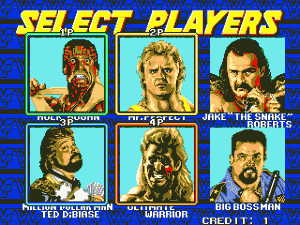 In tag team mode, players could also perform several double-team manoeuvres by tagging their partner when the opponent is positioned correctly, or by making a tag when holding the opponent in a headlock. There was also a power-up available after a team member had been waiting on the apron for a certain length of time, where they would be more powerful and could take no damage for a short time. This mirrors the way that in a real wrestling match the wrestler who tags in is always fired up and raring to go, in what is known as a “hot tag”. In another nice touch, the Legion of Doom even featured the double team finishing move the Doomsday Device, which, whilst difficult to pull off in the game, was devastating.
In tag team mode, players could also perform several double-team manoeuvres by tagging their partner when the opponent is positioned correctly, or by making a tag when holding the opponent in a headlock. There was also a power-up available after a team member had been waiting on the apron for a certain length of time, where they would be more powerful and could take no damage for a short time. This mirrors the way that in a real wrestling match the wrestler who tags in is always fired up and raring to go, in what is known as a “hot tag”. In another nice touch, the Legion of Doom even featured the double team finishing move the Doomsday Device, which, whilst difficult to pull off in the game, was devastating.
 In terms of graphics and sound, the game takes on what is almost a caricature stlye, where large bold sprites of the WWF Superstars are clear and well-animated. Each is even animated slightly differently depending on their size and they all have unique celebration and finishing taunts. Character selection screens are populated by realistic renderings of the wrestlers, as is the title screen. Throughout the game there are a handful of mini cutscenes, which are drawn in a photo-realistic style, featuring the voice of iconic WWF interviewer “Mean” Gene Okerlund, where the Legion of Doom taunt the player and psych themselves up for the upcoming title match. This accurately mirrors the promos that wrestlers deliver between matches, to get the crowd behind them. Matches also feature ring announcement from former WWF announcer Mike McGuirk, where the wrestlers would walk to the ring and work up the crowd. Voices weren’t featured throughout, but for the time of release they were a welcome addition, and combined with realistic sounds like the crowd chanting and the ring bell ringing, added another layer of authenticity to the title and gave the game a unique charm.
In terms of graphics and sound, the game takes on what is almost a caricature stlye, where large bold sprites of the WWF Superstars are clear and well-animated. Each is even animated slightly differently depending on their size and they all have unique celebration and finishing taunts. Character selection screens are populated by realistic renderings of the wrestlers, as is the title screen. Throughout the game there are a handful of mini cutscenes, which are drawn in a photo-realistic style, featuring the voice of iconic WWF interviewer “Mean” Gene Okerlund, where the Legion of Doom taunt the player and psych themselves up for the upcoming title match. This accurately mirrors the promos that wrestlers deliver between matches, to get the crowd behind them. Matches also feature ring announcement from former WWF announcer Mike McGuirk, where the wrestlers would walk to the ring and work up the crowd. Voices weren’t featured throughout, but for the time of release they were a welcome addition, and combined with realistic sounds like the crowd chanting and the ring bell ringing, added another layer of authenticity to the title and gave the game a unique charm.
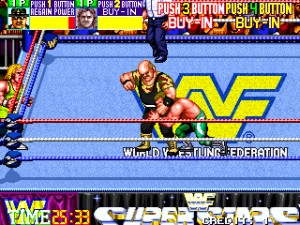 Due to the fact that LJN (a company famous for very poor game adaptations of licensed properties) held the rights to developing WWF games for consoles, Wrestlefest sadly never received a home release. Players have been able to carry on experiencing the excitement of the game through emulation (which also added the ability to control the previously unavailable Legion of Doom) but there are still many voices crying out for a Virtual Console or Xbox LIVE Arcade re-release for example, including a petition campaign. With the amount of fans clamouring to see the game finally come to any console, we can only hope it will come to fruition soon. The best way to experience its sheer fun brand of wrestling would undoubtedly be on an original four-player arcade machine. But the game is too enjoyable to be forgotten so my advice is this: Track down the emulated version and play it, and in the immortal words of Hulk Hogan, don’t forget to say your prayers and eat your vitamins, brother!
Due to the fact that LJN (a company famous for very poor game adaptations of licensed properties) held the rights to developing WWF games for consoles, Wrestlefest sadly never received a home release. Players have been able to carry on experiencing the excitement of the game through emulation (which also added the ability to control the previously unavailable Legion of Doom) but there are still many voices crying out for a Virtual Console or Xbox LIVE Arcade re-release for example, including a petition campaign. With the amount of fans clamouring to see the game finally come to any console, we can only hope it will come to fruition soon. The best way to experience its sheer fun brand of wrestling would undoubtedly be on an original four-player arcade machine. But the game is too enjoyable to be forgotten so my advice is this: Track down the emulated version and play it, and in the immortal words of Hulk Hogan, don’t forget to say your prayers and eat your vitamins, brother!
WWF Wrestlefest is currently only playable via the Raine Arcade emulator. WWE All Stars will be released on March 29th in North America and April 1st across Europe. It will be available for Xbox 360, Nintendo Wii, PlayStation 3, PlayStation 2 and PSP. Stay tuned for the GodisaGeek review soon!
The God is a Geek Retro Corner will return on the first friday of next month.







